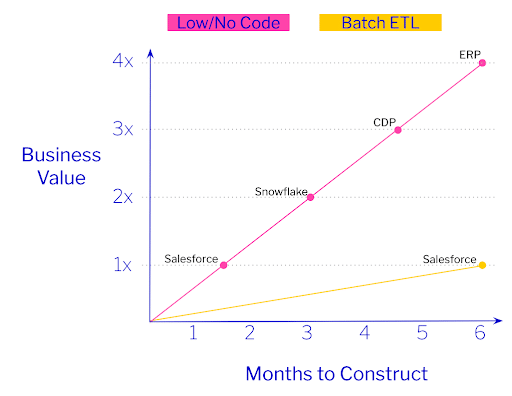Data has always been a valuable asset for businesses, but it has become crucial for survival in the digital age. With the explosion of data from digital channels and IoT devices, organizations find storing, managing and analyzing information increasingly challenging. The recent evolution of data management has responded to this challenge as businesses strive to make sense of the vast amounts of data and turn it into actionable insights.
As the world embraces data and the technology that brings it to life, we see four key themes emerging in data management: Artificial intelligence (AI), data virtualization, real-time integration, and multi-cloud strategies. These trends, while not exhaustive, are top of mind for us as we work with our customers and partners to implement modern cloud-based master data management (MDM) solutions that make data-driven decisions, interactions, and operations possible. Below, we discuss these trends and how MDM solutions are critical to unlocking the full potential of each.
AI and MDM: The Perfect Partnership
Few things are more ubiquitous than AI and machine learning (ML) in technology today. Most businesses seek to integrate AI into their operations for many reasons, such as applying advanced analytics and machine learning to automate decisions and actions, helping save valuable time, resources, and precious capital.
AI can be a valuable tool in data management as it can help build a more efficient data supply chain. By automating specific tasks and processes, AI can help speed up data flow from collection to analysis and decision-making. This can save time and resources, allowing organizations to use their data better. AI can also help data stewards manage and organize data more effectively. For example, AI can classify and label data, identify patterns and trends, and monitor data quality. This allows data stewards to focus on more strategic tasks like designing and implementing data governance policies.
AI can help organizations create accurate, trustworthy, valuable data products by analyzing large amounts of data and identifying patterns and trends. Cloud-based MDM solutions can help organizations maximize the value of their AI initiatives. For example, MDM and AI work together to significantly enhance entity resolution, relationship management, data quality, and data governance. With AI, enterprises can implement validation rule sets, standardization, cleanse, and enrichment activities as part of a robust master data management (MDM) platform. This allows for detecting and resolving issues before they occur without human intervention. Enterprises can leverage AI and machine learning to automate these processes by creating match algorithms and rule sets. This allows for keeping up with data changes over time and ensuring the accuracy of insights.
But AI is no panacea–it can’t solve everything and is not a tool that can be applied in every circumstance. It is crucial to temper expectations for AI because it can’t deliver digital transformation by itself or the immediate, game-changing results that some leaders may wish for.
Data Virtualization: The New Frontier in Enterprise Data Management
Data virtualization is more than just a buzzword; it’s another potential game-changer for enterprise architecture. By aligning physical data assets with customers’ needs and providing contextual expertise within data management teams, data virtualization helps improve data discovery and aligns data ownership. But before diving in, consider how data virtualization aligns with your organizational needs, governance approach, and data governance maturity.
With the explosion of data from digital channels and IoT devices, organizations find it challenging to store, manage and analyze data effectively. Data virtualization offers a solution to this problem by providing a more distributed form of data management that aligns better with the physical data assets that customers need.
While data virtualization is an essential solution for enterprise architecture, it is not a one-size-fits-all solution. Organizations should fully integrate an MDM solution in the stack to harness the benefits of data virtualization. MDM is critical for ensuring data accuracy, completeness, consistency, and maintaining a single version of the truth.
When implemented as part of a virtual data architecture, MDM ensures that data is consistent across different systems and applications and accurate and up-to-date. This is critical when organizations want to unlock the full potential of their data. MDM also helps to improve data security by providing a centralized approach to data management and by helping to ensure that only authorized users have access to sensitive data. This is particularly important in today’s digital landscape, where data breaches are increasingly common.
Say Goodbye to Data Latency with Real-time Integration
Real-time integration is critical for organizations seeking to improve their data management capabilities. At its core, real-time integration connects data, technology assets, and applications while continuously distributing data. Organizations can accelerate data flow and improve accuracy by removing latency and providing real-time data distribution.
Real-time integration is particularly beneficial for MDM and operational use cases. By providing “on-demand” data pipelines, organizations can feed the same data set to analytical and operational use cases. For example, a service representative can access real-time updates that flow through MDM and the data supply chain, vastly improving the customer service experience. This helps improve operational data management enabling organizations to connect directly to their data without replicating it.
Enterprises can achieve real-time integration via cloud-based MDM solutions with no-code connectors and low-code integration. These tools can remove barriers to integration by reducing construction efforts by 75%. Organizations can extend data into additional solutions like Salesforce and Snowflake faster, easier, and with a lower total cost of ownership, enabling data management teams to move with the speed of the business.

When you have an API-driven architecture behind a SaaS solution, having the ability for those to be real-time makes anything that you can do through the API, anything you can do on that platform, capable of real-time. And we are seeing that with customers not only the data integration pieces but also actual operational integration to support real-time customer interactions at the point of sale. We’re seeing where MDM is now part of that technology stack, not just in the analytics or data warehouse space. Real-time integration using these approaches to solve things allows that to happen.
Leveraging Multi-Cloud for Best-in-Breed Solutions
A multi-cloud strategy leverages multiple cloud service providers to gain access to an organization’s best functionality and features. This approach allows businesses to choose the best-of-breed solutions from different providers and implement what works best for their needs.
One key benefit of a multi-cloud strategy is that it minimizes the risk of disruption. An enterprise can protect its systems and ensure business continuity by using multiple cloud providers and building redundancies. This is particularly important for mission-critical systems that must be up 24/7 or have “five nine” types of availability.
For example, a financial services company may use Amazon Web Services (AWS) for data storage and processing and Microsoft Azure for disaster recovery. This allows it to take advantage of AWS’s scalability and security features while ensuring its data is protected in a disaster. Another example is a retail company that uses Google Cloud Platform (GCP) for its e-commerce services and AWS for its analytics and data warehousing. This allows a company to take advantage of GCP’s speed and reliability for its online store and AWS’ analytics capabilities for data-driven decision-making.
When selecting software and vendor packages, it’s essential to make sure that they support a multi-cloud approach. Companies should avoid buying something that locks it into one cloud as this restricts their ability to move functionality from one cloud to another.. MDM solutions, for example, should be available and function on multiple clouds. This allows flexibility and ensures that vendors develop the software to use the best features and functions across all clouds for the most optimal solution.
MDM Solutions are Key to Navigating the Changing Data Management Landscape
Data management has become more critical than ever in the digital age as the amount of data continues to expand. Four key trends in data management: AI, data virtualization, real-time integration, and multi-cloud strategies, have emerged to respond to this challenge. The most critical factor underlying these trends is the clean, connected real-time master data delivered through cloud-based master data management solutions. Cloud-based MDM solutions are foundational to data-driven decisions, interactions, and operations. It allows organizations to have a single, accurate, consistent view of their data, streamline operations, provide insights, and improve collaboration and communication. In short, master data management is the key to turning data chaos into data clarity and is essential for businesses to survive and thrive in the digital age.

